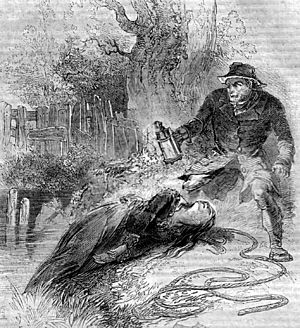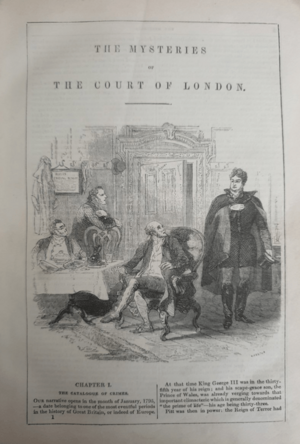George W. M. Reynolds facts for kids
George William MacArthur Reynolds (born July 23, 1814 – died June 20, 1879) was a British writer and journalist. He wrote many popular stories and was also a key figure in a movement called Chartism, which fought for the rights of ordinary people.
Reynolds was born in Sandwich, Kent, England. His father was a high-ranking officer in the Royal Navy. Reynolds went to military school at Sandhurst, planning to join the British Army. However, his parents passed away in 1829. With the money he inherited, he decided to leave the military and become a writer instead. He traveled a lot, especially in France, and even became a French citizen. In 1834, he started an English newspaper in Paris, but it didn't succeed. He returned to England in 1836. In 1840, he became the editor of The Teetotaler, a newspaper that encouraged people not to drink alcohol.
Contents
Writing Popular Stories
Reynolds wrote many popular stories throughout his life. His first novel, The Youthful Imposter, came out in 1835. He later became the editor of The Monthly Magazine from 1837 to 1838. Even though he is not as well-known today, he was more widely read than famous authors like Charles Dickens during his time. A magazine called The Bookseller even called him "the most popular writer of our times" when he died.
His most famous work was a long story series called The Mysteries of London, which started in 1844. This series was inspired by a French story, Les Mystères de Paris. The Mysteries of London sold an amazing 40,000 copies every week! Over a million copies were sold in total before it was even put into full books. It was also translated into French, German, Italian, and Spanish. Even when the German version was banned, it became very popular in secret in Russia.
The Mysteries of London and its even longer follow-up, The Mysteries of the Court of London, are important examples of the "urban mysteries" style of writing. These stories took ideas from Gothic novels, which often featured haunted castles and heroes in danger. But instead, they focused on the poverty, crime, and violence found in big cities.
Most of Reynolds's works, including The Mysteries of London, were first published as weekly "penny dreadfuls" or "Penny Bloods." These were cheap, exciting stories with dramatic pictures, mostly read by people with less money or education. Reynolds had unusual ideas about religion and politics, but his stories were written for his middle- and lower-class readers.
One of his other famous books was Wagner, the Wehr-Wolf. This was a gothic novel about a character who becomes a werewolf after making a deal with the devil. This book was so popular that it was republished in 1975.
Reynolds's novels stayed in print for a long time in both Britain and America. An edition of his book Ciprina from 1875 listed 40 of his novels. The Mysteries of the Court of London was translated into Marathi and Urdu and remained a best-seller in India well into the 1900s.
Involvement in Chartism
Reynolds was also a very important person in the Chartist movement. Chartism was a political movement in Britain during the 1830s and 1840s. It aimed to gain more rights for working-class people, especially the right to vote.
In 1846, Reynolds started two magazines: Reynolds' Miscellany (RM) and The London Journal (LJ). In 1849, he founded Reynolds's Political Instructor. This newspaper later became Reynolds Weekly Newspaper in May 1850. It was the main newspaper for people who wanted big changes after the Chartist movement. This newspaper continued to be published long after Reynolds died, finally ending in 1967.
From 1849 to 1856, Reynolds wrote a signed article every week for Reynolds's Political Instructor and Reynolds's Weekly Newspaper. In these articles, he shared his strong opinions on the important political issues of the day.
In 1854, he moved to Herne Bay, Kent. There, he became one of the town's Improvement Commissioners, helping to manage local affairs. Reynolds supported the idea of British Republicanism. This meant he believed Britain should be a republic, without a king or queen. Much of his writing, especially in the 1870s, pushed for a more equal society and often pointed out problems with the royal family.
Selected Works
George W. M. Reynolds wrote a huge number of books and stories. It can be tricky to know exactly which ones he wrote because some American publishers would put his name on books he didn't write. Also, not all his works were published as the cheap weekly "penny dreadfuls." Here are some of the works that have been confirmed as definitely written by Reynolds:
Novels
- The Youthful Imposter (1835)
- Pickwick Abroad; or, The Tour in France (1837-1838)
- Grace Darling; or, the Heroine of the Ferne Islands (1839)
- The Mysteries of London; First Series (1844-1846)
- Wagner, the Wehr-Wolf (1846-1847)
- The Mysteries of the Court of London; First Series (1848-1850)
- Mary Price; or the Memoirs of a Servant Girl (1851-1853)
- The Soldier's Wife (1852-1853)
Shorter Fiction and Short Stories
- The Father (1838)
- The Drunkard's Tale (1840)
- The Assassin (1845)
- The Greek Maiden; or The Banquet of Blood (1850)
Translation
- The Last Day of a Condemned Man (1829) by Victor Hugo
Poetry
- A Sequel to Don Juan (1843)
Miscellaneous Works
- The Errors of the Christian Religion Exposed (1832)
- The Anatomy of Intemperance (1840)
- The French Self-Instructor (1846)
Journalism Career
Reynolds was also an editor for many publications:
- The Monthly Magazine of Politics, Literature, and the Belles-Lettres (1837-1838)
- The Teetotaller (1840-1841)
- The London Journal (1845-1846)
- Reynolds's Miscellany (1846-1869)
- Reynolds's Political Instructor (1849-1850)
- Reynolds's Weekly Newspaper (1850-1879)
Images for kids




